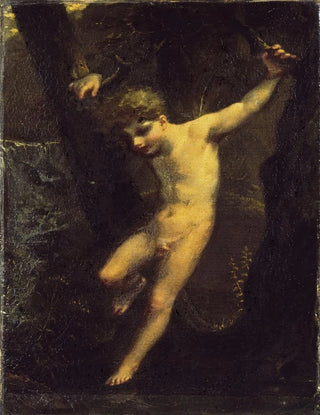Art print | Le Zéphyr - Pierre-Paul Prud'hon


View from behind

Frame (optional)
Art print Le Zéphyr - Pierre-Paul Prud'hon – Captivating Introduction
In the vibrant universe of Romantic painting, the artwork "Le Zéphyr" by Pierre-Paul Prud'hon stands out for its delicacy and poetry. This mythological representation, where love and nature intertwine, embodies an idealized vision of the world, where human emotions blend harmoniously with the elements. The scene depicts the wind god, Zéphyr, carrying the beautiful Psyche in a gentle breath, a moment suspended between dream and reality. The beauty of this piece lies not only in its dynamic composition but also in how Prud'hon manages to capture the lightness of movement, inviting the viewer to immerse themselves in this painting imbued with sensuality and grace.
Style and uniqueness of the work
Prud'hon, master of chiaroscuro, uses light to sculpt his figures and create an ethereal atmosphere. In "Le Zéphyr," fluid curves and soft tones blend to bring a vibrant scene to life. The light, almost transparent drapery reveals the beauty of the bodies while maintaining a certain modesty. The artist skillfully plays with shadows and highlights, emphasizing the volumes and depth of the composition. This painting is a true ode to feminine beauty, where the figure of Psyche is highlighted by a subtle contrast with the background, creating a sensation of floating. The color palette, dominated by pastel tones, evokes a dreamlike atmosphere, reinforcing the idea of a journey beyond tangible limits. Every detail, from the wind's breath to the tenderness of gestures, demonstrates technical mastery and unparalleled artistic sensitivity.
The artist and his influence
Pierre-Paul Prud'hon, born in 1758, is an emblematic figure of French Neoclassicism and Romanticism. His artistic journey, marked by encounters with masters such as Jacques-Louis David, shaped his unique style, blending academic rigor with Romantic sensitivity. Prud'hon established himself as an innovator, notably through his bold use of light and his ability to express complex emotions through

Matte finish

View from behind

Frame (optional)
Art print Le Zéphyr - Pierre-Paul Prud'hon – Captivating Introduction
In the vibrant universe of Romantic painting, the artwork "Le Zéphyr" by Pierre-Paul Prud'hon stands out for its delicacy and poetry. This mythological representation, where love and nature intertwine, embodies an idealized vision of the world, where human emotions blend harmoniously with the elements. The scene depicts the wind god, Zéphyr, carrying the beautiful Psyche in a gentle breath, a moment suspended between dream and reality. The beauty of this piece lies not only in its dynamic composition but also in how Prud'hon manages to capture the lightness of movement, inviting the viewer to immerse themselves in this painting imbued with sensuality and grace.
Style and uniqueness of the work
Prud'hon, master of chiaroscuro, uses light to sculpt his figures and create an ethereal atmosphere. In "Le Zéphyr," fluid curves and soft tones blend to bring a vibrant scene to life. The light, almost transparent drapery reveals the beauty of the bodies while maintaining a certain modesty. The artist skillfully plays with shadows and highlights, emphasizing the volumes and depth of the composition. This painting is a true ode to feminine beauty, where the figure of Psyche is highlighted by a subtle contrast with the background, creating a sensation of floating. The color palette, dominated by pastel tones, evokes a dreamlike atmosphere, reinforcing the idea of a journey beyond tangible limits. Every detail, from the wind's breath to the tenderness of gestures, demonstrates technical mastery and unparalleled artistic sensitivity.
The artist and his influence
Pierre-Paul Prud'hon, born in 1758, is an emblematic figure of French Neoclassicism and Romanticism. His artistic journey, marked by encounters with masters such as Jacques-Louis David, shaped his unique style, blending academic rigor with Romantic sensitivity. Prud'hon established himself as an innovator, notably through his bold use of light and his ability to express complex emotions through






